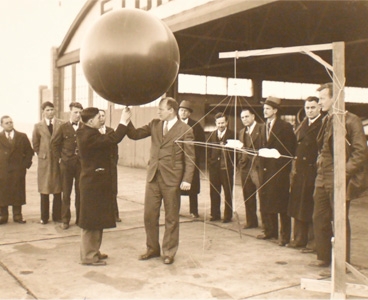Rossby: Tapping into the Stratosphere
Rossby: Tapping into the Stratosphere
Modern meteorology was just getting off the ground when Carl Rossby joined MIT. Prior to January 1936, some of the world’s premier physicists used models of cold fronts and polar air masses, along with plane-mounted instruments, to forecast the weather. But Rossby and his new MIT colleagues K.O. Lange, director of the flying laboratory, and professor Daniel C. Sayre, the veteran research pilot, wanted to know the atmospheric conditions at 18,000 feet. And new technology from Vilho Väisälä, a Finnish entrepreneur who supplied “robot-reporters” or radiosondes—that measure and transmit temperature, relative humidity, and barometric pressure readings—could make this possible.
Attached to helium-filled balloons, the men released the devices, soaring upward to 40,000 feet, collecting data as they went.

Read more in Boston Globe Ideas about how this collaboration opened the study of meteorology—expanding the quantifiable “atmosphere”, and coordinating nationally to build academic programs and a network of meteorological centers.
Rossby went on to found the study of meteorology and physical oceanography at MIT, where he was appointed to the faculty in the Department of Aeronautics in 1928. This group later developed into the first Department of Meteorology in an academic institution in the United States, and is the direct ancestor of PAOC. He is responsible for identifying and characterizing the jet stream and the long waves in the westerlies that were later called Rossby waves.
Wind, war and weathermen: How a Swedish bon vivant let MIT introduce modern meteorology to America — just in time to help the Allies win World War II.